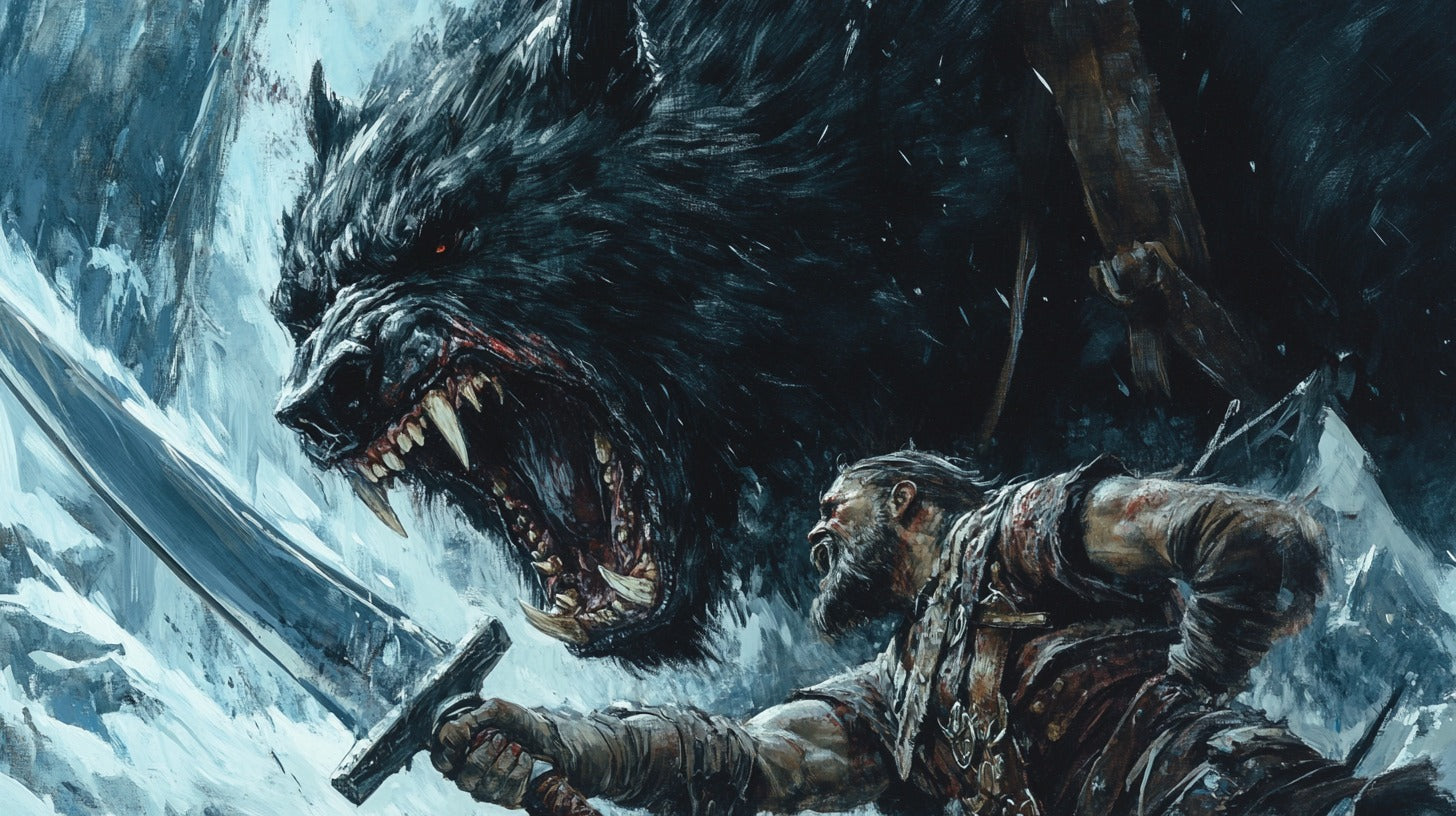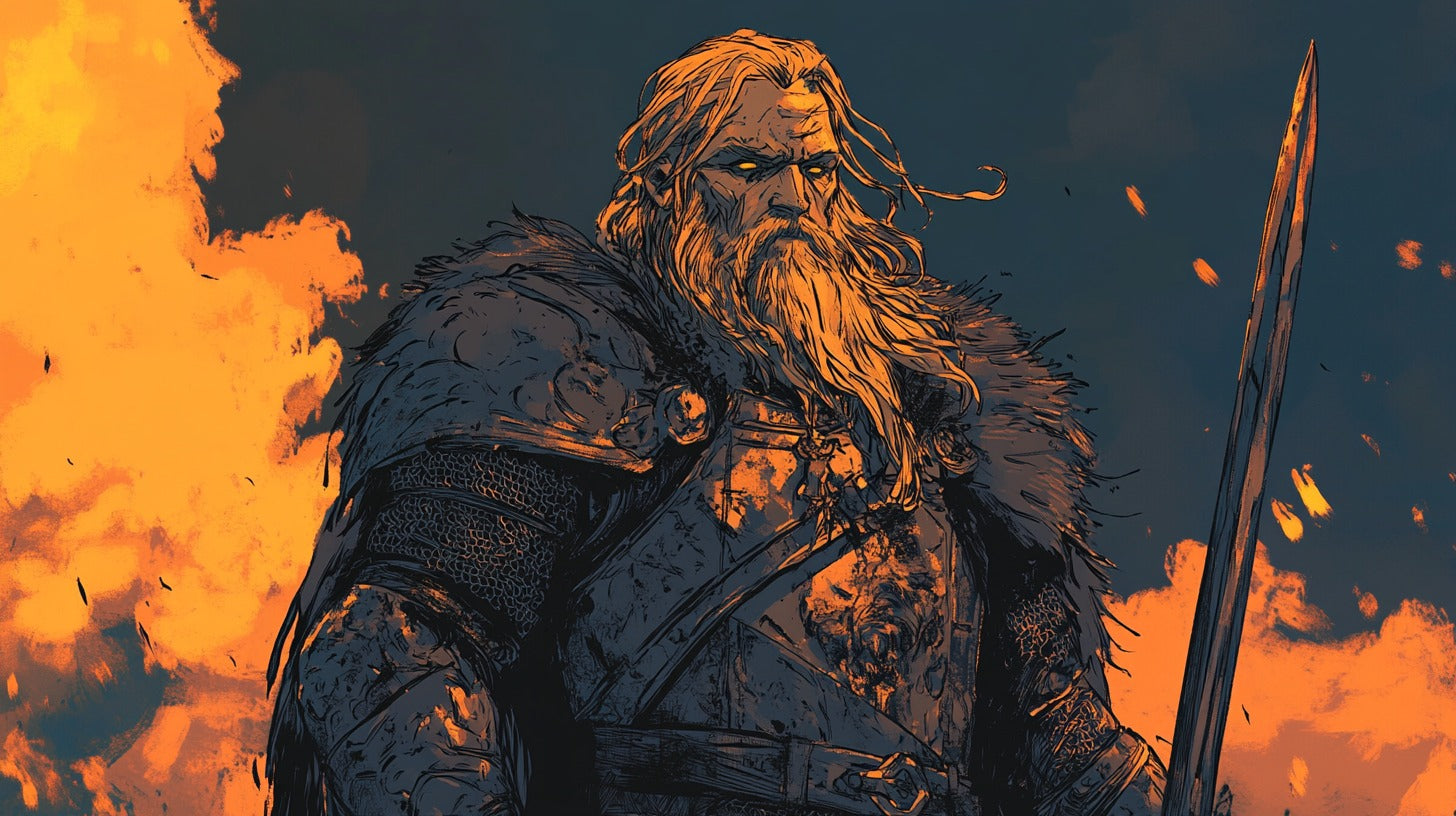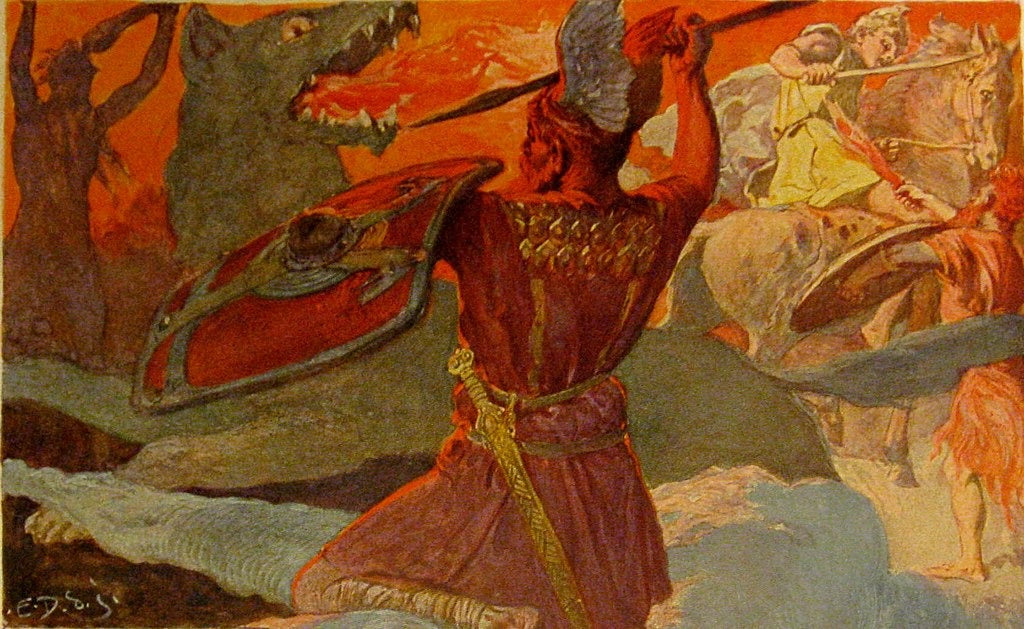
Ragnarök: The Twilight of the Norse Gods
Ragnarök, often translated as "Fate of the Gods" or "Twilight of the Gods," represents one of the most significant elements of Norse mythology. This cosmic event describes the ultimate destruction of the Nine Worlds and the death of many major Norse deities, followed by the world's subsequent rebirth. The concept appears prominently in various Old Norse literary sources, particularly the Poetic Edda and Snorri Sturluson's Prose Edda from the 13th century.
Historical Context and Sources
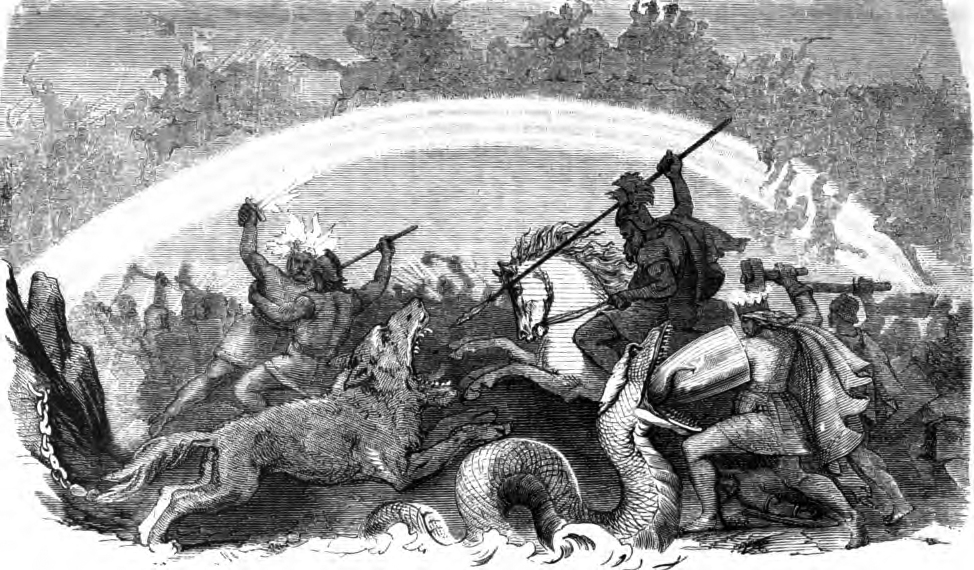
Battle of the Doomed Gods (by Friedrich Wilhelm Heine, 1882)
Primary Literary Sources
The most detailed accounts of Ragnarök come from two primary sources: the Poetic Edda, particularly the poem Völuspá (The Prophecy of the Seeress), and Snorri Sturluson's Prose Edda, specifically in the Gylfaginning section. The Völuspá, composed around 1000 CE but preserved in manuscripts from the 13th century, presents the narrative through the vision of a völva (seeress) who describes both the creation and destruction of the world. These texts provide our most comprehensive understanding of how the Norse people viewed their world's ultimate fate.
Archaeological Evidence
Archaeological findings have significantly enhanced our understanding of Ragnarök's cultural significance. The picture stones from Gotland and various runestones across Scandinavia provide visual representations of scenes that scholars have connected to Ragnarök. Perhaps most notably, the Gosforth Cross in Cumbria, England, dated to the 10th century, displays imagery interpreted as depicting scenes from Ragnarök, demonstrating the tale's spread beyond Scandinavia. These artifacts offer tangible evidence of how deeply embedded these apocalyptic beliefs were in Norse culture.
The Events of Ragnarök

Heimdall & Gjallarhorn Algiz Rune Ragnarok Pendant
Prelude and Prophecies
The coming of Ragnarök is heralded by a series of dire events. The murder of Baldr, the god of light and purity, initiates the chain of events leading to the world's end. Following this tragedy, moral decay spreads throughout the Nine Worlds. Traditional bonds of kinship dissolve as society crumbles, with families turning against one another in unprecedented strife. The immediate approach of Ragnarök is marked by three consecutive winters without any intervening summer, known as Fimbulvetr, bringing unimaginable hardship to all living beings.
The Great Winter (Fimbulvetr)
During Fimbulvetr, the "Mighty Winter," an unprecedented cold and darkness descends upon Miðgarð. This period witnesses the complete breakdown of human society, as wars rage unchecked and social order collapses entirely. The cosmic wolves Sköll and Hati finally succeed in their eternal pursuit, devouring the sun and moon respectively, plunging the world into permanent darkness. This dramatic celestial event marks the point of no return in the progression toward Ragnarök.
Battles of the Gods
The central phase of Ragnarök unfolds as a series of predestined confrontations between the gods and their ancient enemies. Heimdallr and Loki meet in a final battle, resulting in their mutual destruction. The god Týr faces the monstrous hound Garmr, with neither surviving their encounter. Þórr (Thor) confronts Jörmungandr, the World Serpent, successfully slaying the beast but succumbing to its venom after taking nine steps. The god Freyr meets his end against Surtr, having previously given away his magical sword, while Óðinn faces the wolf Fenrir, ultimately falling to the creature but being avenged by his son Víðarr.
The World's Destruction
The final phase of Ragnarök brings about the complete annihilation of the cosmos. Surtr, the fire giant, wields his flaming sword to set the Nine Worlds ablaze. The world tree Yggdrasill trembles to its roots as mountains crumble and the land sinks into the sea. The very fabric of the universe unravels as stars plummet from the sky, and the cosmos descends into primordial chaos. This total destruction, however, carries within it the seeds of renewal.
The New World

The new world that rises after Ragnarök, as described in Völuspá (depiction by Emil Doepler, 1905)
From the depths of destruction emerges a new world, rising from the sea like a phoenix from the ashes. Among the survivors are Víðarr and Váli, sons of Óðinn, alongside Þórr's sons Móði and Magni. Baldr and Höðr return from their exile in Helheim, bringing with them the promise of a brighter future. The surviving gods convene on Iðavöllr, where they discover the golden game pieces once owned by the Æsir, symbolizing the continuation of divine order. Two humans, Líf and Lífþrasir, emerge from their sanctuary in Hoddmímis holt to repopulate the renewed world.
Cultural Impact and Interpretations
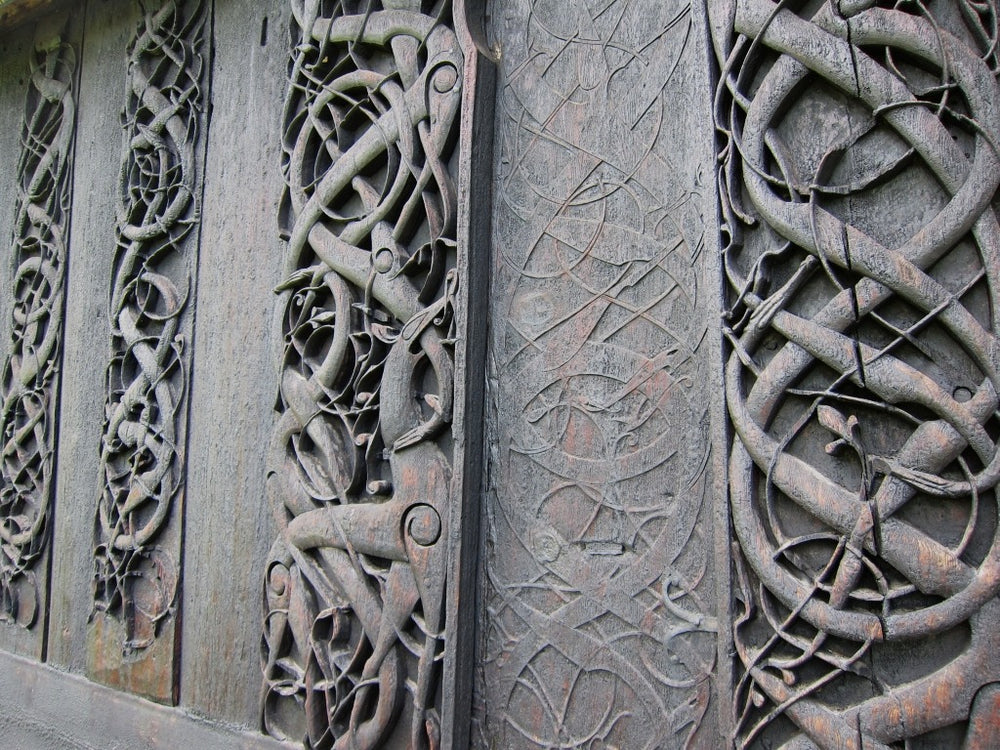
The carved portals from the 12th-century Urnes stave church has been interpreted as containing depictions of snakes and dragons that represent Ragnarök.
Medieval Interpretations
The concept of Ragnarök underwent significant interpretation during the medieval period, particularly as Christianity spread through Norse territories. Medieval Christian scholars frequently drew parallels between Ragnarök and the Biblical Apocalypse, viewing the Norse end-times through a Christian lens. Snorri Sturluson's 13th-century account in the Prose Edda reveals this complex interplay between pagan and Christian traditions. While maintaining the core narrative of the Norse myth, his writing shows subtle influences of Christian eschatology, though scholars continue to debate the extent of this influence. The preservation of Ragnarök traditions during this period of religious transformation provides valuable insights into how medieval Scandinavians reconciled their ancestral beliefs with new religious paradigms.
Modern Cultural Influence
The enduring power of Ragnarök continues to resonate throughout modern culture, influencing diverse forms of artistic expression. Richard Wagner's monumental opera cycle "Der Ring des Nibelungen" stands as perhaps the most famous artistic interpretation, though it takes considerable creative liberties with the original myth. Contemporary adaptations have found new relevance in the narrative, particularly in its themes of environmental catastrophe and cyclical renewal. Modern authors, filmmakers, and artists frequently draw upon elements of Ragnarök to explore contemporary concerns about climate change, social collapse, and renewal after destruction. Video games, comics, and popular literature have reimagined these ancient themes for new audiences, demonstrating the continued relevance of this powerful mythological narrative.
Scholarly Debates and Analysis
The academic study of Ragnarök has generated intense scholarly discussion across multiple disciplines. Comparative mythologists, led by Georges Dumézil, have identified structural parallels between Ragnarök and other Indo-European end-time narratives, suggesting deeper cultural connections across ancient civilizations. Contemporary scholars debate the extent to which surviving accounts reflect pre-Christian beliefs versus medieval interpretations. The role of oral tradition in transmitting and potentially transforming the narrative remains a subject of academic inquiry. Archaeological evidence continues to provide new insights into how these beliefs manifested in material culture, while literary scholars examine the sophisticated poetic devices used to convey the apocalyptic vision.
Frequently Asked Questions (FAQs)
- Was Ragnarök believed to be inevitable?
According to Norse mythology, Ragnarök was considered a predestined event that even the gods could not prevent. This fatalistic view reflected the Norse understanding of destiny and cosmic order.
- What happens to ordinary humans during Ragnarök?
Most humans perish during the events of Ragnarök, particularly during the Fimbulvetr (Great Winter) period. However, two humans named Líf and Lífþrasir survive by sheltering in Hoddmímis holt, and they become the progenitors of the new human race.
- How does Ragnarök differ from other apocalyptic myths?
While many cultures have end-time myths, Ragnarök is unique in depicting the death of the gods themselves and emphasizing a cyclical nature of destruction and renewal. Unlike many apocalyptic myths, it focuses on the gods' foreknowledge of their doom yet their determination to fight regardless.
- What role does Loki play in bringing about Ragnarök?
Loki serves as a catalyst for Ragnarök through his role in Baldr's death and his fathering of three monstrous children: Fenrir, Jörmungandr, and Hel. These offspring play crucial roles in the destruction of the cosmos and the deaths of major gods.
- Why does the world tree Yggdrasill shake during Ragnarök?
Yggdrasill's shaking symbolizes the complete unraveling of cosmic order. As the axis mundi connecting the Nine Worlds, its trembling represents the dissolution of the boundaries between realms and the collapse of the established universal structure.
References
Sturluson, Snorri. (1987). Prose Edda. Translated by Anthony Faulkes. Viking Society for Northern Research.
Larrington, Carolyne. (2014). The Poetic Edda. Oxford University Press.
Lindow, John. (2001). Norse Mythology: A Guide to Gods, Heroes, Rituals, and Beliefs. Oxford University Press.
Clunies Ross, Margaret. (1994). Prolonged Echoes: Old Norse Myths in Medieval Northern Society. Odense University Press.
Dumézil, Georges. (1973). Gods of the Ancient Northmen. University of California Press.
Orchard, Andy. (2002). Dictionary of Norse Myth and Legend. Cassell.
Davidson, H.R. Ellis. (1964). Gods and Myths of Northern Europe. Penguin Books.
Turville-Petre, E.O.G. (1964). Myth and Religion of the North: The Religion of Ancient Scandinavia. Holt, Rinehart and Winston.
